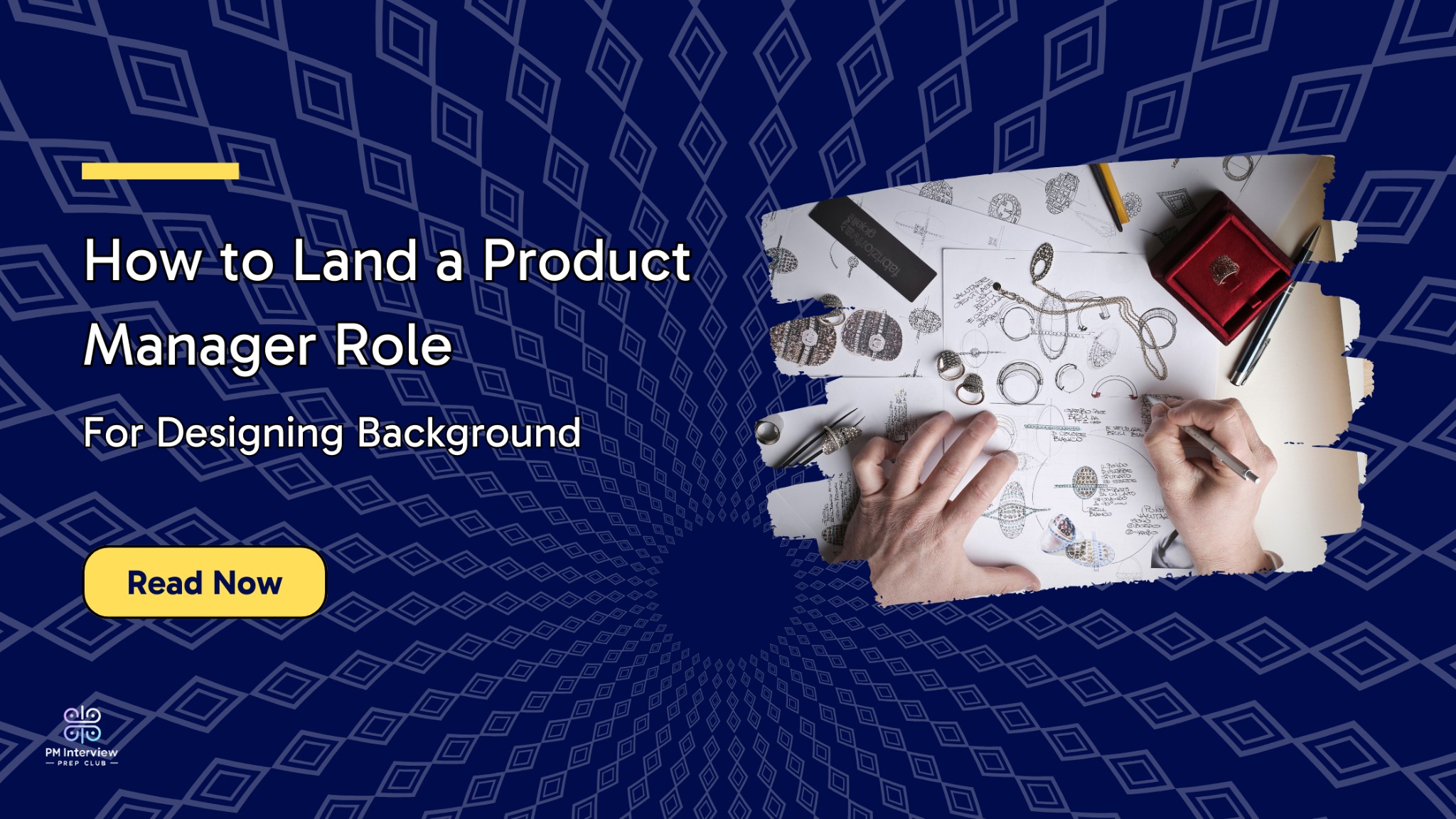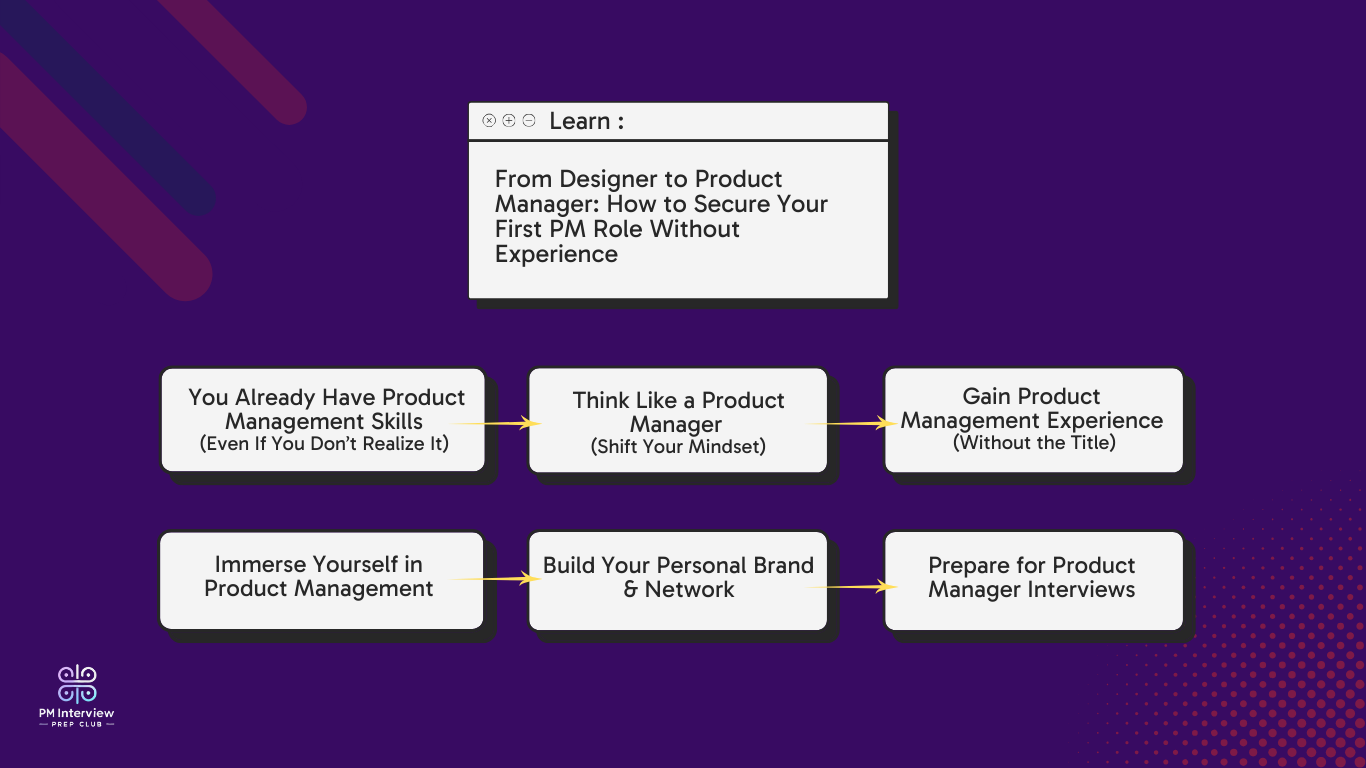How to Land a Product Manager Role Without Prior PM Experience – A Designer’s Journey
How to Land a Product Manager Role Without Prior PM Experience – A Designer’s Journey

Imagine walking into a PM interview with the confidence that comes from knowing you already have a secret weapon: your design expertise. You’ve spent years perfecting digital experiences and crafting intuitive interfaces. Now, picture leveraging that talent to drive product strategy, influence business decisions, and shape the future of a product. For many designers, the leap to product management isn’t a shot in the dark—it’s a natural evolution. In this guide, we share actionable steps, real-life examples, and expert tips to help you make that transition confidently.
1. Recognize the PM Skills You Already Possess
Your Design Background is More Powerful Than You Think
- User-Centric Approach: You’ve conducted user research, built personas, and mapped pain points—core skills that PMs use to identify customer problems.
- Prototyping & Communication: Your ability to translate abstract ideas into wireframes and prototypes mirrors the PM’s role in communicating vision to stakeholders.
- Cross-Functional Collaboration: Whether you’ve worked with engineers, marketers, or leadership teams, you’ve already navigated the complexities of teamwork—an essential PM trait.
Story Spotlight: Consider Sarah, a talented designer who once hesitated to apply for PM roles. When she realized that her deep understanding of user needs and iterative design process directly translated to effective product strategy, she began positioning herself as a hybrid professional. Today, she’s not only designing products but also leading strategic initiatives that have redefined her company’s roadmap.
Takeaway: Recognize and leverage your innate product management skills. List your experiences and see how each aligns with core PM responsibilities.
2. Shift Your Mindset – Think Like a Product Manager
Expand Your Focus Beyond Aesthetics
- Business Impact & Strategy: Learn to see beyond design. Ask yourself why a feature exists, how it drives business goals, and what user problem it solves.
- Prioritization Frameworks: Familiarize yourself with models like RICE (Reach, Impact, Confidence, Effort) and MoSCoW (Must-have, Should-have, Could-have, Won’t-have) to decide what brings the most value.
- Data-Driven Decision-Making: Embrace quantitative tools (Google Analytics, Mixpanel, Amplitude) to complement your qualitative insights and help measure success.
Pro Tip: Always ask “why” at every stage. This habit not only deepens your understanding of a product’s purpose but also prepares you for strategic discussions in PM interviews.

3. Gain PM Experience Without the Title
Take Charge and Build Your Portfolio Now
- Own Your Projects: Start by leading product-related discussions at your current job. Volunteer for tasks like competitor analysis or user testing beyond design.
- Launch Side Projects: Use no-code platforms such as Webflow, Bubble, or Adalo to take a product from concept to launch. These projects serve as practical experience and great portfolio pieces.
- Create Product Case Studies: Choose a product you love, analyze its strengths and weaknesses, and propose improvements. Document your thought process as a real-life PM case study.
Example in Action: Mark, a designer turned aspiring PM, started a side project building a niche app. By documenting his process—from ideation to user feedback—he built a case study that not only boosted his confidence but also attracted the attention of recruiters.
Call-to-Action: Ready to practice real-world product management scenarios? Join PMInterviewPrep.Club for hands-on bootcamps and digital hangouts that simulate the PM interview experience.
4. Immerse Yourself in the World of Product Management
Surround Yourself with Knowledge and Community
- Essential Reading: Dive into books like The Lean Product Playbook, Inspired, Hooked, and Cracking the PM Interview to build a solid foundation.
- Join PM Communities: Engage in discussions on LinkedIn, Product Hunt, and specialized forums such as Mind the Product. Real-world insights from current PMs can be invaluable.
- Follow Blogs & Podcasts: Subscribe to The Product Podcast, Product Coalition, and industry newsletters to stay current with trends and best practices.
- Find a Mentor: Connecting with experienced PMs provides guidance, feedback, and encouragement—accelerating your learning curve.
Community Highlight: At PMInterviewPrep.Club, our weekly digital hangouts bring together aspiring and seasoned PMs. These sessions offer a chance to share experiences, ask questions, and learn strategies that work in real interviews.
5. Build Your Personal Brand & Network
Visibility is Key to Opportunities
- Optimize Your LinkedIn: Highlight your transferable skills, projects, and product insights. Share regular updates about your learning journey and case studies.
- Engage with the Community: Comment on industry posts, join PM discussions, and share your experiences on social media. Your voice matters in the conversation.
- Attend Events: Whether online or offline, webinars, meetups, and conferences provide direct access to hiring managers and industry leaders.
Insider Tip: Your network is your net worth. Engage authentically and share your journey—each interaction can open doors to new opportunities.
6. Prepare for Product Manager Interviews
Practice Makes Perfect
- Study Common Questions: Familiarize yourself with case studies, product sense scenarios, behavioral assessments, and technical questions.
- Simulate the Experience: Practice with peers or mentors. Use structured platforms like PMInterviewPrep.Club, where you can engage in mock interviews and receive real-time feedback.
- Reflect and Iterate: After each practice session, review your performance. Identify areas for improvement and adjust your approach accordingly.
Final Note: Cracking PM interviews isn’t just about having the right answers—it’s about demonstrating a strategic mindset, effective communication, and the ability to think on your feet.
Wrap-Up & Next Steps
Transitioning from design to product management is a journey of self-discovery, learning, and growth. By recognizing your inherent PM skills, shifting your mindset, actively seeking hands-on experience, and engaging with a vibrant community, you can confidently position yourself for a PM role.
What’s Your Story? Have you taken any steps toward transitioning into product management? Share your experiences or questions in the comments below. We’d love to hear your journey and help you along the way.
Join Our Community: If you’re ready to take the next step, explore our resources at PMInterviewPrep.Club and join our upcoming digital hangouts to connect with like-minded professionals.
